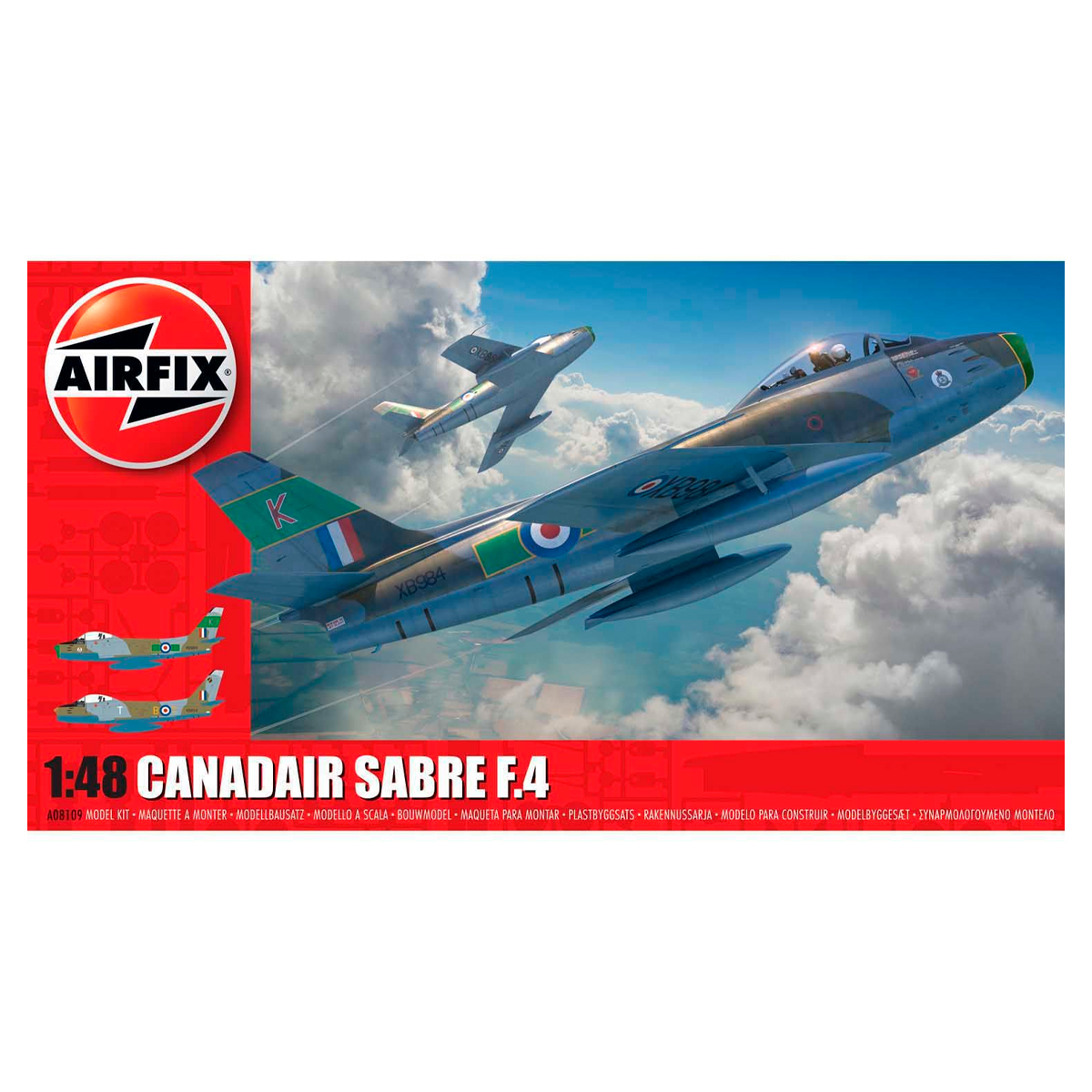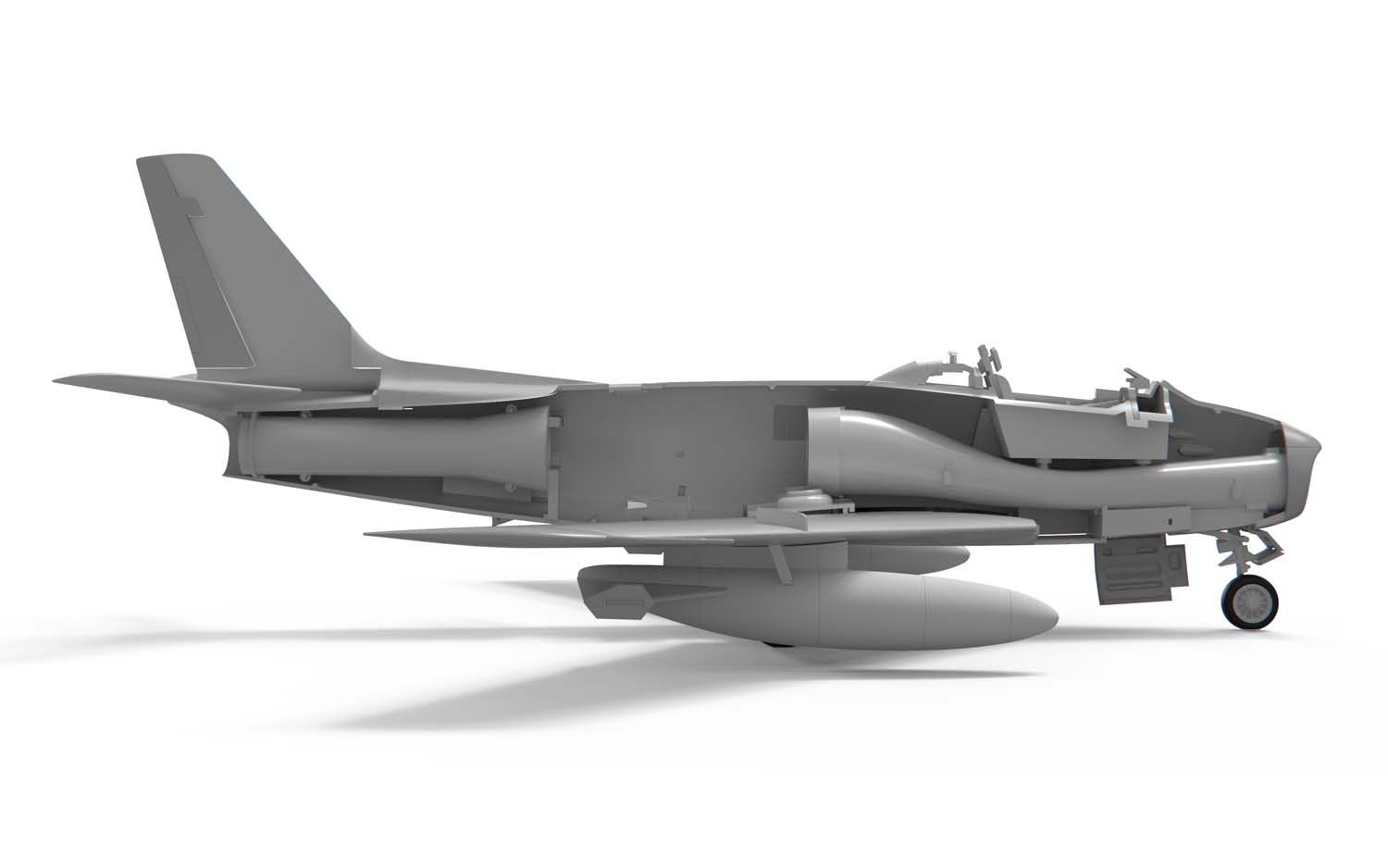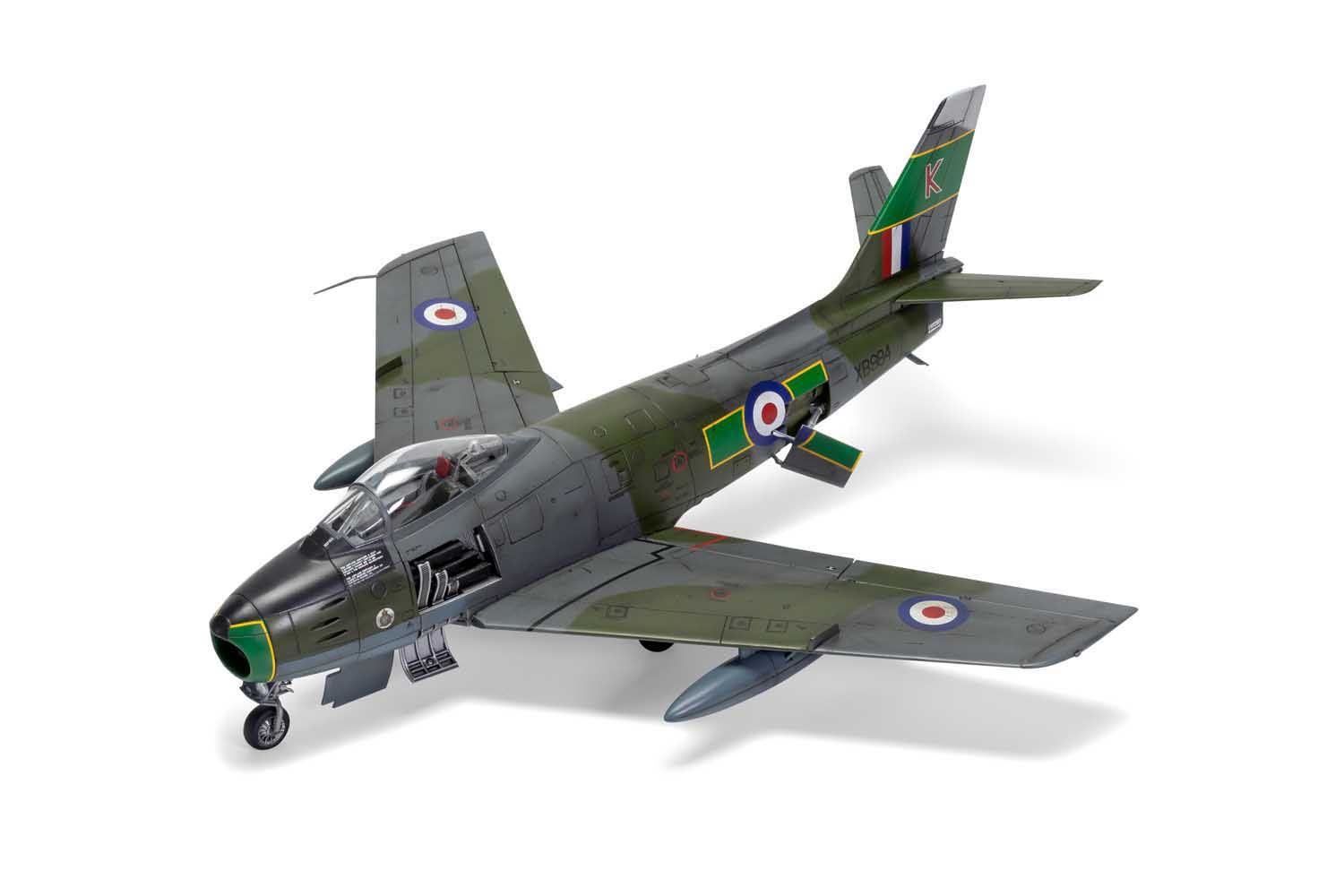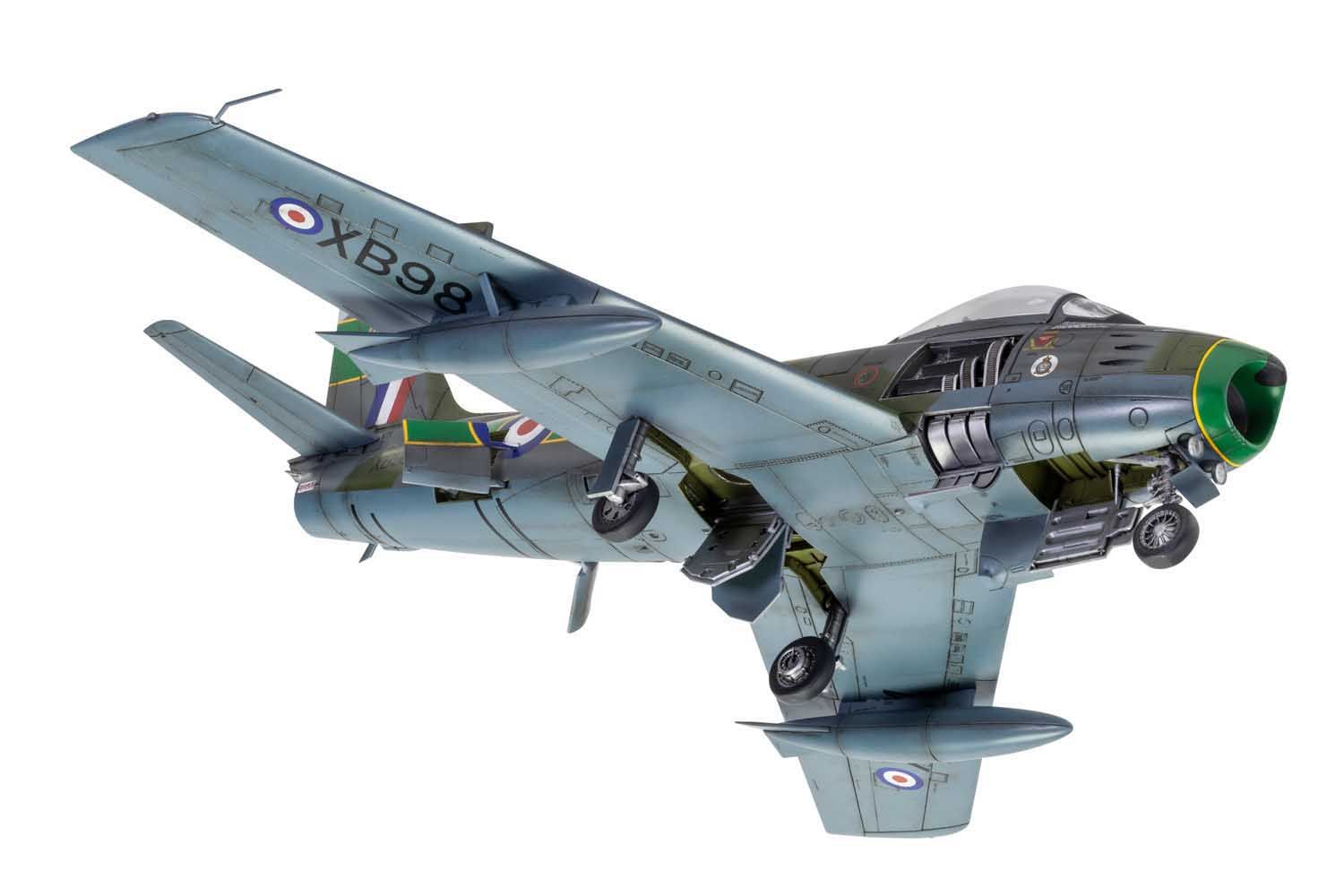Canadair Sabre F.4 1/48
42,95€
Solo quedan 1 disponibles

*Please check our Privacy Policies to see how to we use your personal data.
*Por favor revisa nuestra Política de Privacidad para ver como tratamos tus datos personales
The last few months of the Second World War saw the introduction of the worlds first operational jet aircraft and with their appearance, a clear indication as to the future of aviation. Taking a significant lead in jet powered aviation technology, Germany was at least 12 months ahead of their Allied adversaries in this regard and with the end of the conflict, there was a rush to gain access to as much of this information as possible, so it could be applied to British, American and Soviet aviation projects. In the US, the aviation industry had concentrated their efforts on perfecting piston powered aviation during the war, a decision which was vindicated through the success of the P-51 Mustang and the sheer numbers available to Allied air forces. Inevitably, this would have an impact on Americas entry into the jet age and whilst their first operational jet fighter, the Lockheed P-80 Shooting Star, was an excellent aircraft, it utilised the straight wing technology synonymous with WWII designs.
With its P-51 Mustang being widely regarded as the best single engined fighter of WWII, it was not long before the designers at North American aviation applied their undoubted talents to producing a new jet powered fighter, one which would incorporate research material obtained from the German jet programme. In their quest for ever greater speed, the new aircraft featured a 35% wing sweep and beautifully streamlined fuselage, whilst retaining the exceptional pilot visibility first introduced on the D variant of the Mustang. With three nose mounted .50 calibre machine guns on either side of the fuselage, the new Sabre shared much with the attributes of its piston engined predecessor, beautiful to look at, but a deadly fighting aeroplane.
The first flight of the XP-86 prototype took place on 1st October 1947, in the hands of famous WWII Pearl Harbor Curtiss P-40 fighter ace George Welsh, who was North Americans chief test pilot at that time. Later in the development programme, an F-86A Sabre would go on to set a new world airspeed record of 670.84 mph, underlining the credentials of this important new fighter.
On entering USAF service in 1949, the North American F-86 Sabre was not only Americas first swept wing fighter, but also the fastest fighter in the world and one of the most important aircraft in the post war jet era. The Korean War would witness the advent of the first jet versus jet combat and pitch Americas new jet fighter against the latest Soviet design, the highly capable Mikoyan Gurevich MiG-15, an aircraft which possessed a great aviation pedigree of its own and one which proved to be quite a shock for Western Powers. With both aircraft possessing advantages over the other, this aerial duel would prove to be quite an even contest, with the more robust training and previous WWII experience of Sabre pilots proving decisive in the end.
Whilst US military planners were quick to publish combat victory ratios of 10:1 in favour of the F-86 Sabre, later research suggested the Sabres dominance was probably nearer 3:1, though still underlining the effectiveness of the aircraft. As one of the worlds first classic jet fighters, the F-86 Sabre was produced in great quantities and went on to serve with around 30 of the worlds air forces, as well as being produced under licence in Canada, Australia, Japan and Italy.
Out of a final total production run which exceeded 9,800 aircraft, the Royal Air Force would operate around 430 Canadian built Sabres from 1953 until 1956, as the introduction of the excellent Soviet MiG-15 continued to have an impact on NATO military strategies. With the indigenously designed Supermarine Swift and Hawker Hunter still in development, the Sabre provided the RAF with a capable jet fighter at a crucial period in world history and whilst they would only see service for a relatively short period, it bought the RAF valuable time until they could introduce their own swept wing fighter designs.
Tech Specs
Item Length – Without Packaging (cm) 22.9
Item Height – Without Packaging (cm) 8.88
Item Width – Without Packaging (cm) 22.9
How many pieces will be found in the box opened by the customer? 148
Item Scale 1:48
Contents: Sprues & decals
Number of Scheme options 2
Skill Level 2
Flying Hours 3
Wingspan (mm) 229
Los últimos meses de la Segunda Guerra Mundial fueron testigos de la introducción de los primeros aviones a reacción operativos del mundo y, con su aparición, de un claro indicio sobre el futuro de la aviación. Alemania, a la cabeza de la tecnología aeronáutica a reacción, llevaba al menos 12 meses de ventaja a sus adversarios aliados en este campo y, con el final del conflicto, se apresuró a acceder a la mayor cantidad posible de esta información para poder aplicarla a los proyectos de aviación británicos, estadounidenses y soviéticos. En Estados Unidos, la industria aeronáutica había concentrado sus esfuerzos en perfeccionar la aviación de pistón durante la guerra, una decisión que se vio confirmada por el éxito del P-51 Mustang y el gran número de unidades disponibles para las fuerzas aéreas aliadas. Inevitablemente, esto repercutiría en la entrada de América en la era de los reactores y, aunque su primer caza a reacción operativo, el Lockheed P-80 Shooting Star, era un avión excelente, utilizaba la tecnología de alas rectas sinónimo de los diseños de la Segunda Guerra Mundial.
El P-51 Mustang estaba considerado como el mejor caza monomotor de la Segunda Guerra Mundial, por lo que los diseñadores de North American Aviation no tardaron en aplicar su indudable talento a la producción de un nuevo caza a reacción, que incorporaría material de investigación obtenido del programa alemán. En su búsqueda de una velocidad cada vez mayor, el nuevo avión presentaba un 35% de barrido alar y un fuselaje bellamente aerodinámico, al tiempo que conservaba la excepcional visibilidad del piloto introducida por primera vez en la variante D del Mustang. Con tres ametralladoras del calibre 50 montadas en el morro a ambos lados del fuselaje, el nuevo Sabre compartía muchos de los atributos de su predecesor con motor de pistón: bonito a la vista, pero un avión de combate letal.
El primer vuelo del prototipo XP-86 tuvo lugar el 1 de octubre de 1947, en manos del famoso as de caza Curtiss P-40 de la Segunda Guerra Mundial, George Welsh, que en aquel momento era el piloto de pruebas jefe de North Americans. Más adelante en el programa de desarrollo, un F-86A Sabre establecería un nuevo récord mundial de velocidad de 670,84 mph, subrayando las credenciales de este importante nuevo caza.
Al entrar en servicio en la USAF en 1949, el North American F-86 Sabre no sólo fue el primer caza de ala barrida de América, sino también el caza más rápido del mundo y uno de los aviones más importantes de la era de los reactores de posguerra. La Guerra de Corea fue testigo del primer combate entre aviones a reacción, en el que se enfrentaron el nuevo caza a reacción americano y el último diseño soviético, el muy capaz Mikoyan Gurevich MiG-15, un avión que poseía un gran pedigrí aeronáutico propio y que resultó ser toda una sorpresa para las potencias occidentales. Con las ventajas que ambos aviones tenían sobre el otro, este duelo aéreo resultó ser bastante igualado, y el entrenamiento más sólido y la experiencia previa en la Segunda Guerra Mundial de los pilotos de Sabre resultaron decisivos al final.
Mientras que los planificadores militares estadounidenses se apresuraron a publicar ratios de victoria en combate de 10:1 a favor del F-86 Sabre, investigaciones posteriores sugirieron que el dominio del Sabre era probablemente más cercano a 3:1, aunque subrayando la efectividad del avión. Como uno de los primeros cazas a reacción clásicos del mundo, el F-86 Sabre se produjo en grandes cantidades y llegó a servir en unas 30 fuerzas aéreas de todo el mundo, además de producirse bajo licencia en Canadá, Australia, Japón e Italia.
De una producción final total que superó los 9.800 aviones, la Royal Air Force operaría alrededor de 430 Sabres construidos en Canadá desde 1953 hasta 1956, mientras la introducción del excelente MiG-15 soviético seguía teniendo un impacto en las estrategias militares de la OTAN. Con el Supermarine Swift y el Hawker Hunter de diseño propio aún en desarrollo, el Sabre proporcionó a la RAF un caza a reacción capaz en un periodo crucial de la historia mundial y, aunque sólo entraría en servicio durante un periodo relativamente corto, permitió a la RAF ganar un tiempo valioso hasta que pudiera introducir sus propios diseños de cazas de ala barrida.
Especificaciones técnicas
Longitud del artículo – Sin embalaje (cm) 22,9
Altura del artículo – Sin embalaje (cm) 8,88
Anchura del artículo – Sin embalaje (cm) 22,9
¿Cuántas piezas se encontrarán en la caja abierta por el cliente? 148
Escala del artículo 1:48
Contenido: Matrices y calcas
Número de opciones de esquema 2
Nivel de habilidad 2
Horas de vuelo 3
Envergadura (mm) 229















 Solicitud de ficha producto tipo SDS / Seguridad de producto
Solicitud de ficha producto tipo SDS / Seguridad de producto